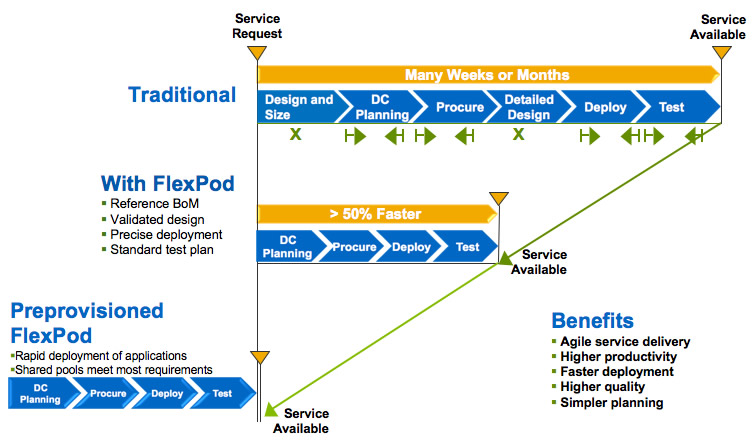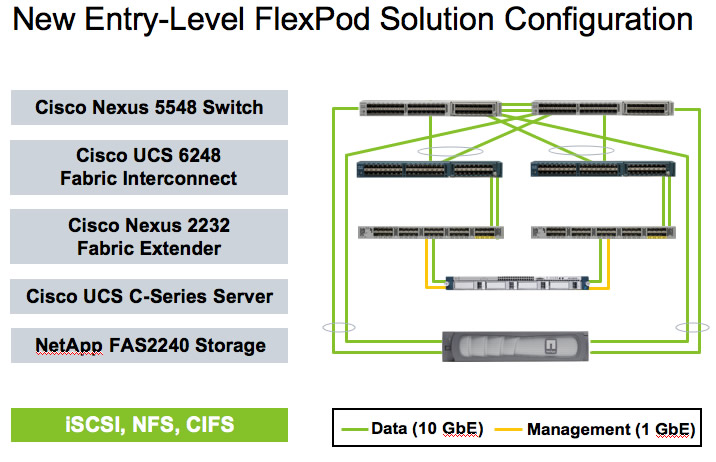




Since its introduction in late 2010, the FlexPod® data center platform—a pretested and validated solution from NetApp and Cisco—has been tremendously successful. FlexPod configurations have been installed by more than 600 customers in over 30 countries worldwide. Companies of all sizes and in nearly every industry are adopting FlexPod in locations that range from Barrow, Alaska, to Melbourne, Australia, to Cape Town, South Africa. Customers and resellers attribute this success to FlexPod’s ease of deployment and low risk.
From the beginning we have seen demand for a scaled-down FlexPod configuration that meets tight IT budgets and is sized properly for the data centers of businesses with 500 to 1,000 employees. We have also had requests from current FlexPod customers to extend the FlexPod solution so that it addresses smaller proof-of-concept or satellite data center workloads in large enterprises.
That’s why Cisco and NetApp have created an entry-level FlexPod solution: to address requirements for smaller workloads while helping you to deploy shared infrastructure quickly and ease the transition to virtualization and the cloud. This entry-level FlexPod solution is designed to deliver the same benefits as our original FlexPod offering—it has the same architecture, same technology, and same management—but it is sized (and priced) for more modest requirements. This new solution is fully compatible with the original FlexPod solutions, and you can scale an entry-level FlexPod through the full FlexPod solution range when needed.
This article takes a closer look at the entry-level FlexPod solution, including hardware and software components, scale-up and scale-out, and how to get started.
Understanding Requirements for an Entry-Level FlexPod

When we looked at the requirements for a smaller-scale FlexPod we considered two cases.
- Smaller workloads in large, typically distributed enterprises. Purchasers of the original FlexPod were quick to tell us that they would like a version sized for smaller data centers in distributed locations and satellite offices and for smaller needs like proof-of-concept deployments.
- Midsize enterprises. We also heard from other businesses that can benefit from the FlexPod architecture on a smaller scale. These businesses have the same need for the full FlexPod feature set, with integrated data protection, advanced efficiency, and simplified management, but they need a FlexPod solution sized to meet their business needs and tight budgets.
In designing a FlexPod data center platform for midsize businesses, we identified some unique challenges. First, the majority of the IT budget in these companies goes to maintaining what they have. Many of these companies buy servers and keep them for five years before they refresh. This means that they need to look a lot further down the road when choosing new hardware, so flexibility and investment protection are important.
When these businesses do have a technology refresh, it’s often driven by the need to upgrade major tier-1 software applications such as Microsoft® SharePoint® or Microsoft Exchange. With support for Exchange 2003 scheduled to end in 2012, some 500 million mailboxes will have to be upgraded over the next 12 months. Smart businesses are asking themselves which new platform will make them best prepared for the next five years.
We believe that midsized enterprises that make the move to a shared, virtualized infrastructure will be best positioned to take advantage of emerging cloud technologies over the next two to three years. As cloud technologies mature, companies will be able to move virtual machines to take advantage of additional resources in the cloud as they’re needed.
This is where an entry-level FlexPod solution comes in. By standardizing the architecture and validating common virtualization platforms and workloads, FlexPod helps you take the risk out of new deployments. The first validated workload for the entry-level FlexPod architecture is VMware® vSphere®, a very common virtualization platform. Microsoft Exchange and SharePoint will also be supported workloads.
FlexPod Advantages
An entry-level FlexPod architecture offers a number of unique advantages to meet the needs of large enterprises and midsize enterprises alike. FlexPod, including the entry-level solution, makes it easy to deploy shared infrastructure. Components are integrated and standardized for fast, repeatable, consistent deployment. As a member of the larger FlexPod reference architecture, the entry-level FlexPod solution eliminates much of the guesswork involved in:
- Resource procurement
- Capacity planning and sizing
- Making the transition to virtualization and the cloud
- Operations and provisioning

Figure 1) FlexPod decreases the time needed to procure and deploy new infrastructure. Once in place, new applications and services can be provisioned quickly based on validated configurations.
Advantages include:
- Faster deployment with less risk. The prevalidated design means that you can get FlexPod up and running quickly and deploy applications faster with fewer problems.
- Enterprise value at entry-level price. The entry-level FlexPod solution uses best-in-class components and offers capabilities that are typically lacking in other entry-level solutions. You don’t have to sacrifice performance, scalability, or efficiency for affordability.
- Investment protection. The scalability and flexibility of FlexPod give the solution a longer life. You can easily repurpose components to address changing needs.
- Ease of scaling up and out. Unlike other turnkey solutions, the entry-level FlexPod grows and adapts to meet your evolving needs.
A Scalable, Entry-Level FlexPod Design

As with the original FlexPod design, the entry-level FlexPod is based on best-in-class NetApp® and Cisco® components and has been fully validated by Cisco and NetApp. Our technical staff has performed over 12,000 hours of testing on FlexPod in the lab. Best practices for all FlexPod variations, including the entry-level solution, are described in Cisco Validated Design documents that simplify FlexPod deployment.
Storage
The entry-level FlexPod utilizes the NetApp FAS2240 storage system, which was described in detail in a recent Tech OnTap article. The unified storage architecture of the FAS2240 allows it to be configured to meet both NAS (NFS and CIFS) and SAN (iSCSI) data access requirements, and it delivers all the capabilities you would expect from a NetApp storage platform, including integrated data protection and leading storage efficiency with built-in support for thin provisioning, deduplication, and compression.
The FAS2240 runs the same Data ONTAP® operating environment as larger NetApp platforms, so it provides essentially the same capabilities and is managed in the same way as the FAS3200 series storage system included in the original FlexPod. Staff trained on existing FAS or FlexPod systems will find the FAS2240 just as easy to use.
Servers
On the compute side, the entry-level FlexPod solution will initially be validated with four Cisco Unified Computing System™ (UCS™) C-Series rack-mount servers, each with two quad-core CPUs. In all ways that matter—provisioning, management, and so on—UCS B-Series and C-Series servers are functionally identical, making them an ideal choice for all FlexPod models.
Cisco UCS controls all server attributes for C-Series (and B-Series) in the software layer to make the computing hardware within the entry-level FlexPod stateless. Cisco UCS completely virtualizes the server hardware, networking, and storage access with virtual MAC and WWN addresses. Should a server fail, assigning the role of that server to a different server works seamlessly without any need to reconfigure VLANs or switches. Cisco UCS Manager makes it simple to deploy or redeploy servers using service profiles that can be replicated for rapid deployment. The overall results are enhanced scalability, availability, and efficiency.
Unified Fabric
FlexPod creates an end-to-end low-latency, lossless 10-Gigabit Ethernet (10GbE) unified network fabric that consolidates all LANs, SANs, and high-performance computing networks. This unified fabric lowers costs by reducing the number of network adapters, switches, and cables, and by decreasing power and cooling requirements.
Switching is provided by two Cisco Nexus® 5548UP switches. Each 1RU switch provides up to 960 gigabits per second of throughput and scales up to 48 ports. (Ports include 32 1/10-Gigabit Ethernet fixed enhanced Small Form-Factor Pluggable Ethernet/FCoE or 1/2/4/8-Gbps native FC unified ports and 3 expansion slots.)
Two Cisco UCS-6248 fabric interconnects with Cisco UCS Manager software provide a redundant management and communications backbone for UCS components. The UCS-6248 offers 48 ports with up to 960Gbps bandwidth and 2-millisecond port-to-port latency. Two Cisco Nexus 2232 fabric extenders provide 32 10GbE server ports and 8 10GbE uplink ports.

Figure 2) Entry-level FlexPod architecture. All management and data paths are redundant.
Management
The Cisco UCS Manager provides embedded management of all Cisco components of the entry-level FlexPod. NetApp OnCommand™ tools simplify the management of NetApp storage and related functions such as backup/restore and replication.
To facilitate integration into existing management frameworks, each layer in a FlexPod—network, compute, storage—provides open APIs for integration with management and orchestration products from BMC, CA, Cisco, Cloupia, DynamicOps, Gale, IBM, Microsoft, VMware, and others. A recent Tech OnTap article describes our approach to FlexPod management.
Design for Virtualization
Although the entry-level FlexPod solution supports both physical and virtualized deployments, it is ideally suited to support virtualized environments. It is also designed to accommodate common virtualization software such as that from VMware and Microsoft.
FlexPod Scaling

Like the other FlexPod configurations, an entry-level FlexPod can scale up for greater performance and capacity and it can scale out to provide consistent, multiple deployments.
Scale Up
One of the capabilities that distinguishes FlexPod from competing solutions is the ability to scale. With many prepackaged solutions you pay the price in terms of significant limitations.
A FlexPod is not a fixed configuration. While the FlexPod reference architecture provides an excellent starting point it also allows you to scale different resources (compute, network, storage) for larger requirements; the underlying elements that make up a FlexPod are designed with scalability and growth in mind.
Compute. You can scale server infrastructure through the addition of UCS-C systems or UCS-B blades or both; additional servers become part of a single UCS management domain.
Storage. The FAS2240 supports up to 24 disk drives in the base chassis. It can support up to a total of 144 disk drives, providing a maximum raw capacity of just over 400TB, through the addition of external disk shelves. Should your needs exceed the I/O or capacity limits of the FAS2240 you have several options.
- Upgrade in place. The FAS2240 chassis converts to a standard disk shelf. Add the NetApp FAS controller of your choice and you are up and running again without time-consuming or complicated data migration—and without a forklift. If you’re a regular Tech OnTap® reader you know that many NetApp administrators consider this capability a big advantage.
- Add a second storage system. You can add a second NetApp storage system to your FlexPod configuration. You can choose a second FAS2240 or any model from the midrange FAS3200 series or the enterprise FAS6200 series.
Fabric. The hardware that supports the unified fabric of the entry-level FlexPod is designed to support significant scalability in the base configuration. Up to 16 C-Series rack-mount servers can be added to the 2 fabric extenders validated in the entry-level solution. Additional fabric extenders, fabric interconnects, and switches can be added to extend the fabric to scale significantly higher.
Learn More

The presized, validated, and standardized FlexPod architecture offers significant advantages for accelerating the deployment of a virtualized IT infrastructure. FlexPod brings together best-in-class technologies for compute, networking, storage, and virtualization into a preconfigured and easy-to-deploy solution. We’ve made significant efforts to document both the sizing and deployment of the environment to simplify the process of getting started, and open management capabilities let you integrate with whatever tools you currently have in place.
A cooperative support model between Cisco and NetApp provides a more streamlined response to identify and quickly solve potential issues related to shared infrastructures. This saves you valuable time and resources when requesting support.
The entry-level FlexPod solution was announced in April 2012. To learn more about FlexPod, including the entry-level configuration, check out the NetApp FlexPod page and the Cisco FlexPod page. There you’ll find the latest information on all FlexPod configurations and a list of partners you can choose from.








